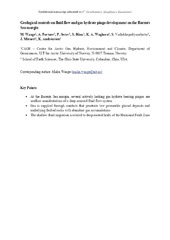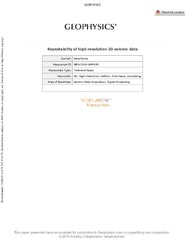| dc.contributor.advisor | Bünz, Stefan | |
| dc.contributor.author | Waage, Malin | |
| dc.date.accessioned | 2019-03-27T10:13:35Z | |
| dc.date.available | 2019-03-27T10:13:35Z | |
| dc.date.issued | 2019-02-18 | |
| dc.description.abstract | Using the state-of-the-art high resolution P-Cable 3D seismic system, in this thesis we (1)
study the shallow strata (<1km below seabed) and describe the geological controls and
driving mechanisms for fluid leakage at two sites in the northern Barents Sea, and (2)
introduce a new time-lapse seismic method for high-frequency (~30-350 Hz) P-Cable seismic
data. The study areas are interesting as they are located close to the upper termination of
the gas hydrate stability zone and may experience ongoing or past growth and decomposition
of gas hydrates. Bjørnøyrenna area hosts over 100 km-wide craters – a possible result of
methane blowouts in the past. In Storfjordrenna, methane venting associates to gas hydrate
bearing mounds (pingos). The northern Barents Sea is an underexplored area compared to
the southern Barents Sea open for petroleum exploration. Therefore, our studies provide
unique insight into the architecture and nature of shallow methane accumulations, fluid flow
dynamics and gas hydrate inventories connected to thermogenic gas reservoirs that are
deemed to occur elsewhere in the region. Our results point towards different geological
controls on fluid flow. In Storfjordrenna, methane from Paleocene strata migrates along
permeable beds and extensional faults linked to the regional Hornsund Fault Complex,
accumulates under Quaternary glacial tills and locally forms gas hydrate chimneys. The
Bjørnøyrenna lacks a glacial cover and the craters are incised in lithified, yet fractured, Triassic
bedrocks. The source and reservoir of methane here is shallow Triassic clinoforms
widespread across the Barents Sea. Furthermore, using 6 P-Cable 3D seismic datasets from
three areas with and without known active fluid flow, we test seismic repeatability at various
geological setting and develop an optimal workflow for 4D seismic approach. The results show
high potential of such high-resolutions time-lapse seismic studies to reveal natural fluid flow
dynamics on a yearly time scale. | en_US |
| dc.description.doctoraltype | ph.d. | en_US |
| dc.description.popularabstract | Methane gas and methane ice (methane hydrates) are common on continental shelves worldwide. Here we investigate the mechanisms leading to methane flow beneath the seabed and its release to the water. We examine the sediments and sedimentary rocks of the Barents Sea using high-resolution 3D seismic data. Moreover, we introduce and test a new method for monitoring methane migration below the seafloor - the 4D seismic. The method is based on acquiring identical 3D seismic data sets with time span of 1-2 years.
We show that 2 studied methane release locations overlie shallow petroleum reservoirs. Tectonic faults favor methane migration from the deep, connecting the reservoirs to the seafloor. Some portions of methane were previously trapped in gas hydrates that melted some 20,000 – 15,000 years ago due to past climate change.
Our time-lapse investigations provide promising results of using the high-resolution 3D seismic system to reveal the dynamic nature of natural methane release sites. | en_US |
| dc.description.sponsorship | The PhD project was funded by VISTA - a basic research program in collaboration between The Norwegian
Academy of Science and Letters, and Statoil (proj. number 6266). The project was integrated
into the sub seabed reservoirs group (WP1) at the Centre of Excellence for Arctic Gas
Hydrates, Environment and Climate (CAGE) (Research Council of Norway (grant no. 223259). | en_US |
| dc.identifier.isbn | 978-82-8236-334-1 (trykt) og 978-82-8236-335-8 (pdf) | |
| dc.identifier.uri | https://hdl.handle.net/10037/15078 | |
| dc.language.iso | eng | en_US |
| dc.publisher | UiT Norges arktiske universitet | en_US |
| dc.publisher | UiT The Arctic University of Norway | en_US |
| dc.relation.haspart | <p>Paper I: Waage, M., Portnov, A.D., Serov, P., Bünz, S., Waghorn, K.A., Vadakkepuliyambatta, S., ... Andreassen, K. Geological controls on fluid flow and gas hydrate pingo development on the Barents Sea margin. (Submitted manuscript). Publisher’s version available at <a href=https://doi.org/10.1029/2018GC007930> https://doi.org/10.1029/2018GC007930</a>. Accepted manuscript version available at <a href= https://hdl.handle.net/10037/14528>https://hdl.handle.net/10037/14528</a>.
<p>Paper II: Waage, M., Serov, P., Andreassen, K., Waghorn, K.A. & Bünz, S. Controls on giant methane blowout craters and mounds on the Arctic seafloor. (Manuscript). Full text not available in Munin.
<p>Paper III: Waage, M., Bünz, S., Landrø, M., Plaza-Faverola, A. & Waghorn, K.A. Repeatability of high-resolution 3D seismic data. (Accepted manuscript). Publisher’s version available <a href= https://hdl.handle.net/10037/14568>https://hdl.handle.net/10037/14568</a>. | en_US |
| dc.rights.accessRights | openAccess | en_US |
| dc.rights.holder | Copyright 2019 The Author(s) | |
| dc.rights.uri | https://creativecommons.org/licenses/by-nc-sa/3.0 | en_US |
| dc.rights | Attribution-NonCommercial-ShareAlike 3.0 Unported (CC BY-NC-SA 3.0) | en_US |
| dc.subject | VDP::Mathematics and natural science: 400::Geosciences: 450::Marine geology: 466 | en_US |
| dc.subject | VDP::Matematikk og Naturvitenskap: 400::Geofag: 450::Marin geologi: 466 | en_US |
| dc.title | 3D and 4D seismic investigations of fluid flow and gas hydrate systems | en_US |
| dc.type | Doctoral thesis | en_US |
| dc.type | Doktorgradsavhandling | en_US |


 English
English norsk
norsk


